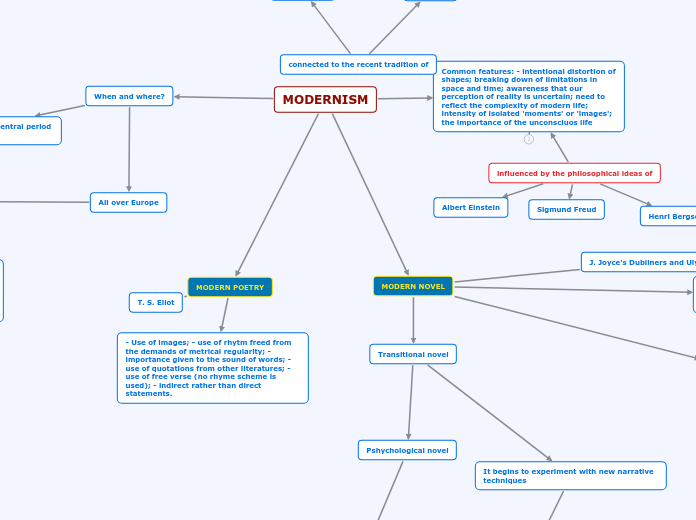Argomento Flottante
Pshychological novel
Also referred to as bridge to the Modern novel; -focus on the development of the character's mind and human relationships; - rejection of traditional canons and shift of focus from external events to inner reactions to those events; - deep analysis of reactions.
Time conceived as a continuous flow causing a lack of chronological order due to the subjective and inner conception of time; - logical order may be lost or lacking; - action takes place within the character's mind; - rejection of omniscent narration; - shifting of the viewpoint; - analysis of the consciousness influenced by the new theories on the subconscious; - importance given to the inner self rather than to society
Stream of consciousness VS interior monologue: stream of consciousness refers to the mental activity, the interior monologue is the instrument used to translate this phenomenon into words. To do so, the interior monologue often disregards logical transitions, formal syntax and punctuation
J. Joyce's Dubliners and Ulysses
T. S. Eliot
aimed at a truthful and concrete presentation of the world perceived by the senses. Term 'imagist' coined by Ezra Pound
-Developped in France; originated in the writings of Baudelaire; - against realism; - wanted to represent individual emotions by suggesting them.
IMAGISM
SYMBOLISM
connected to the recent tradition of
influenced by the philosophical ideas of
Henri Bergson
Albert Einstein
MODERNISM
MODERN NOVEL
It expresses the lack of faith in traditional values and the disillusionment with progress and science
Transitional novel
It begins to experiment with new narrative techniques
J. Conrad's Heart of Darkness
MODERN POETRY
- Use of images; - use of rhytm freed from the demands of metrical regularity; - importance given to the sound of words; - use of quotations from other literatures; - use of free verse (no rhyme scheme is used); - indirect rather than direct statements.
Common features: - intentional distortion of shapes; breaking down of limitations in space and time; awareness that our perception of reality is uncertain; need to reflect the complexity of modern life; intensity of isolated 'moments' or 'images'; the importance of the unconsciuos life
Sigmund Freud
When and where?
All over Europe
Italy
Futursim, after 1909 with Marinetti's Manifesto but mostly in the visual arts (Boccioni) and Hermeticism with Montale, Quasimodo and Ungaretti (difficult style that privileged evocation and verbal suggestion)
first half of the 20th century. Central period falls between 1910 and 1930

